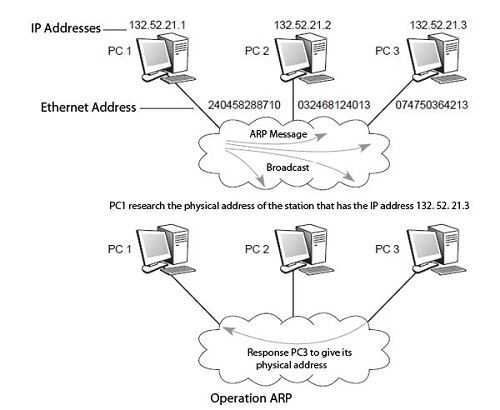IP addresses are assigned independently of the hardware addresses of the machines. To send a datagram on the Internet, the network software must convert the IP address into a physical address, used to transmit the frame.
Address resolution refers to the determination of the address of a device from the address of that equipment to another protocol level. We solve, for example, an IP address in an Ethernet address or an ATM address.
It’s ARP (Address Resolution Protocol) performing this translation between the IP world and Ethernet based on the physical network. ARP enables machines to resolve addresses without using static table that lists all addresses of both worlds. A machine uses ARP to determine the recipient’s physical address by broadcasting an ARP request to the subnet containing the IP address to be translated. The machine with the relevant IP address responds with its physical address. To make ARP more efficient, each machine maintains in memory a table of addresses resolved and thus reduces the number of Broadcast emissions.
At the time of initialization (bootstrap), a mass storage without the machine (diskless) should contact their server to determine its IP address and to use the TCP / IP services. RARP (Reverse ARP) allows a machine to use its physical address to determine its logical address on the Internet. The RARP mechanism allows a computer to be identified as a target on the network by broadcasting a RARP request. The servers receiving the message examine their table and meet. Once the IP address obtained, the machine stores it in memory and no longer uses RARP until it is reset.
The ARP protocol is based on the physical network to perform address translation. To determine the recipient’s physical address, a machine broadcasts an ARP request on the subnet that contains the IP address to be translated. The machine with the relevant IP address responds with its physical address. This process is illustrated in Figure.

Inversely, a station that connects to the network can know its own physical address without an IP address. Upon initialization, the machine will contact the server to determine its IP address and can use the TCP / IP services. RARP allows him to use his physical address to obtain its logical address on the Internet. Through the RARP mechanism, a station can be identified as a target on the network by broadcasting a RARP request. The servers receiving the message examine their table and meet. Once the IP address obtained, the machine stores it in memory and no longer uses RARP until it is reset.
In IPv6, ARP and RARP are replaced by a neighbor discovery protocol called Neighbor Discovery (ND), which is a subset of the control protocol ICMP (Internet Control Message Protocol).
 Dinesh Thakur holds an B.C.A, MCDBA, MCSD certifications. Dinesh authors the hugely popular
Dinesh Thakur holds an B.C.A, MCDBA, MCSD certifications. Dinesh authors the hugely popular